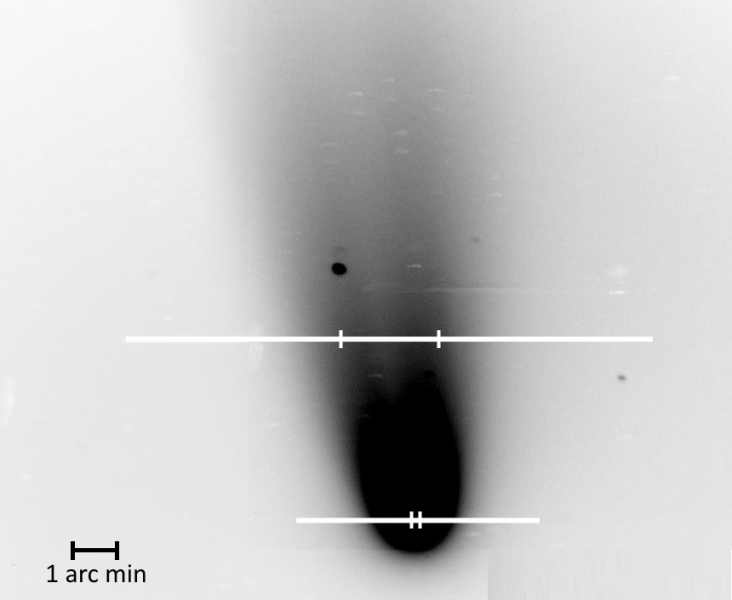Revealing the anatomy of C/2020 F3 (NEOWISE)
2020 October 1
The low surface brightness of most comets beyond the bright central coma makes spectroscopy of these regions difficult. When a bright one like C/2020 F3 comes along though, it gives an opportunity to explore the composition of the cometary material over a wider area.
On the night of 2020 Jul 13, when the comet was 0.43au from the Sun and 0.81au from Earth, I recorded three spectrum images at 12 Ångström resolution using an ALPY 600 spectrograph and a 280mm-aperture, ƒ/5.5 telescope. One was taken with the slit extending 5.2 arcminutes (arcmin) across the coma and two were obtained which, when combined, cover 11arcmin across the tail, 3.6arcmin from the centre of the coma. (Still very much the root of the tail, which extended several degrees in images taken around this time). Figure 1 is a mosaic of images from the spectrograph guider, showing the sampled areas (1arcmin represents 35,000km at this distance from Earth).

The spectrum of the central coma (Figure 2a) shows the familiar emission features seen in most comets,1 though in this case with an additional very prominent line from sodium. Figure 2b is the less familiar spectrum of the tail, rarely seen in amateur spectra, integrated over the brightest region. (The integrated regions are between the vertical lines in Figure 1).
The scattered sunlight from the dust has been subtracted in these spectra to leave just the emission components, using a template spectrum of a Sun-like star (spectral class G2v) with the continuum matched to that of the comet spectrum. The strongest ones are marked.
– NaD: the orange double line from sodium (unresolved at this resolution). This is seen only in comets which come close enough to the Sun to liberate the sodium atoms.
– CN (cyanogen): seen strongly in the spectrum but at the limit of the eye’s sensitivity in the violet.
– C2: the saw-tooth shaped Swan bands which give the familiar blue/green tinge to the coma but which are absent in the tail.
– CO+: A series of double lines which produce the ethereal blue glow seen in images of the ion tail once it diverges from the glare of the sunlit dust.
The spectrum images (Figure 3 – left, coma; right, tail) also contain information about the distribution of these components along the full length of the spectrograph slit. (The scattered sunlight from the comet dust is included in these images).
The intensity distributions for each component in the coma and tail can be seen in Figure 4a & b. The plots cover the full width shown in Figure 1. Note the difference in the horizontal x-scale – the material spreads dramatically away from the coma in the direction of the tail, even over this short distance. The distributions are approximately normalised in the central region.
The distributions differ significantly between the various constituents.
The sodium emission in the coma is confined to a narrow central region and while it spreads out in the tail, it is still narrower than the dust and is offset anticlockwise, consistent with the formation of a separate sodium tail seen for example in an observation by the Planetary Science Institute a few days previously.2 The dust in the tail is bifurcated, though this split is not seen in the other components.
The CN component is seen furthest out around the coma and is very widely distributed even just 3.6arcmin along the tail, spreading beyond the width of the spectrum image.
As with all comets, the opportunity to study C/2020 F3 in detail was fleeting and this was essentially just a snapshot, both in space and time, of the anatomy of this comet. When the next bright one comes along though, I hope other amateurs equipped with spectrographs may be tempted to move the slit away from the glare of the coma and explore the outer reaches.
Robin Leadbeater, Three Hills Observatory
1 Boyd D., ‘Spectra of two spring comets’, J. Br. Astron. Assoc., 130(30), 181 (2020)
2 Morgenthaler J. & Schmidt C., ‘NEOWISE – Rare image of a comet’s sodium tail’, Planetary Science Institute: psi.edu/news/neowisesodiumtail
https://britastro.org/wp-content/uploads/2020/10/fig4_0.PNG
https://britastro.org/wp-content/uploads/2020/10/fig3_0.PNG
https://britastro.org/wp-content/uploads/2020/10/fig2.PNG
| The British Astronomical Association supports amateur astronomers around the UK and the rest of the world. Find out more about the BAA or join us. |
